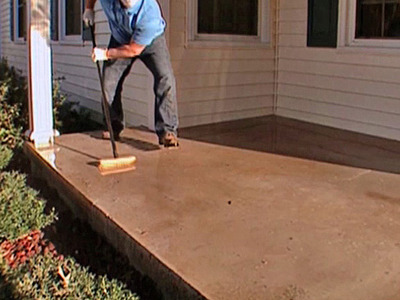Home Improvement
How To Paint A Concrete Patio

If you have a patio that’s cracked, unpainted, or otherwise unappealing to look at, painting is a great option to spruce it up. There are a lot of ways to do it wrong, but if done correctly, painting concrete it is well worth it in the end. Online, there are a lot of horror stories about how painting a concrete patio went wrong, but a little bit of research, time, and effort will save you the trouble of these mishaps.
The first thing to determine when deciding how to paint your floor is whether or not it’s sealed. To figure out if it is or isn’t, pour a glass of water on the concrete and observe how the concrete interacts with it. If the concrete absorbs the water, and turns darker in color, it is unsealed. If the water starts to bead up, it is sealed.
Once you’ve ascertained the flooring, go to your nearest local hardware store and purchase a pole sander, sandpaper, bleach, a long-handled brush, rubber gloves, a respirator mask, concrete and masonry bonding primer, 1 gallon of 1-part epoxy concrete and garage floor paint, as well as rollers and brushes. An insider tip: look for your pole sander in the building supplies section of the hardware store rather than the paint section because you will likely end up finding one for about half the price.
To get rid of pesky stains and grime, use bleach on the surface of the concrete, but be sure to vacuum up all the dirt and small debris that has gathered on the surface before you put any bleach on the concrete. Once it’s all vacuumed, put on your mask and mix in a half-bleach, half-water mixture in a bucket. Then, with your long-handled brush, paint the bleach mixture onto the concrete, and scrub the mixture into the concrete well. After that, rinse off the bleach and water mixture from the concrete with a hose. Rinse it off well to make sure no remaining chemicals are left on the surface. By no means will your concrete floor look brand new after this, but the process will surely lighten up oil and any other kinds of stains, as well as removing all the dirt and grime.

Next, you’ll need to sand down your concrete surface. To do this, attach the scrub brush to the pole sander. Scuff the surface with the sander little by little, working your way across the entire floor. You may not be able to tell the sanding is doing anything, but sanding helps adhere the paint to the concrete. It is essential that you do not skip the sanding step, or the finished product could end up being just another horror story.
Wait for the surface to dry completely, then begin priming the concrete. Priming is important because it helps the paint absorb into the concrete, rather than sitting on top of the surface. Priming also helps your paint job last longer than if you hadn’t primed it. For this step, start off by attaching your pole to a paint roller. Begin to lay down the primer, continuing until the whole surface is covered. Primer is thin and it starts off a white color, slowly turning to clear. It takes about 4 hours for primer to dry completely, but don’t be alarmed if once your primer “dried,” it doesn’t appear dry. Priming will also bring out all the imperfections in the concrete and remain a bit sticky-looking, like glue. You will no longer have a smooth concrete floor, but the stickiness is what helps bind the paint to the surface.
Finally, pick out your paint color. The color you’ll want to choose depends on what kind of look you want to achieve. Colors closer to white will convey a cooler feeling and darker colors will affect a warmer atmosphere, while more neutral colors will be easier to add accent colors to if you decide to put furniture on your patio. If you choose a bolder, more vibrant color, you may want to consider placing more neutral-colored furniture in the area, and vice versa.
Finally, the moment you’ve been waiting for: painting! Put some paint in your paint pan and attach a spankin’ new roller onto your pole. Dip the roller into the pan and start applying the first coat onto the surface. Thinner layers seem to work better, and the first coat should be painted on in a vertical way. The second coat should be applied in a horizontal fashion to ensure the entire surface is sufficiently covered. Paint will be ready to be walked on after 24 hours and furniture can be added to the space after 72 hours. Now you have a newly painted concrete patio where you can enjoy your newly colored life!
Written by Robert Thompson, owner of TLC Lawncare & Landscaping, where they are one of the preferred concrete contractors Columbia MO has to offer. When it comes to decorative or stamped patios, TLC is here to help!
-

 Tech11 years ago
Tech11 years agoCreating An e-Commerce Website
-

 Tech11 years ago
Tech11 years agoDesign Template Guidelines For Mobile Apps
-

 Business6 years ago
Business6 years agoWhat Is AdsSupply? A Comprehensive Review
-

 Business10 years ago
Business10 years agoThe Key Types Of Brochure Printing Services
-

 Tech8 years ago
Tech8 years agoWhen To Send Your Bulk Messages?
-

 Tech5 years ago
Tech5 years ago5 Link Building Strategies You Can Apply For Local SEO
-

 Law5 years ago
Law5 years agoHow Can A Divorce Lawyer Help You Get Through Divorce?
-

 Home Improvement6 years ago
Home Improvement6 years agoHоw tо Kеер Antѕ Out оf Yоur Kitсhеn































